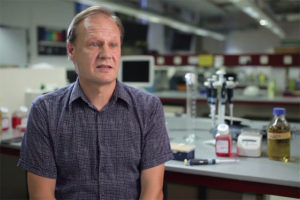Retroviruses in Gene Therapy
Molecular biologist Greg Towers on the great scientific challenges, the dangers of gene therapy, and the way i...
The video is a part of the project British Scientists produced in collaboration between Serious Science and the British Council.
For all mobile organisms and particularly mammals, including ourselves, knowing where we are and being able to find a way around, find a way back to our home, for example, find a way out to resources like food is a crucial cognitive capability. And we’ve recently begun to understand what the neural basis of this kind of spatial navigation is: knowing where you are and knowing how to get to places that you need to get to. So we’re now beginning to really understand what happens in the brain that enables us to know where we are and know how to find a way around and remember where the important places for us are in the environment.
This breakthrough of understanding really began in the late sixties and early seventies with John O’Keefe here at UCL discovering place cells, neurons within the hippocampus, a part of the brain, in animal models like rats and mice. These neurons fire whenever the animal is in a particular part of its environment and a different neuron fires when it’s somewhere else. So together this big population of neurons, if you look at the activity as it varies as the animal moves around its environment, you can tell where the animal is, so which of the pace cells are firing – firing little electrical impulses to other neurons in the brain – that tells you where it is in the environment.
And then the third kind of spatial cell was discovered much more recently in 2005 by Moser in Norway and these are the grid cells. They’re a little bit like place cells in the sense that as the animal moves around its environment, a given cell will fire depending on the location of the animal, but a given place cell will fire whenever it enters any one of a series of locations that are distributed about the environment of an animal in a regular triangular array. It’s a very surprising thing to see given the complexity of behaviours these animals are wandering around. But a given place cell will fire whenever it goes into any of these locations organised in a triangular array across the environment. And a different grid cell will fire on a similar array of locations slightly shifted from the other cell.
So that together in a population of these grid cells, the activity will move from one to another as the animal moves around. And so again, like the place cells, they are telling the rest of the brain in a special kind of way where the animal is. You could work out where the animal is from what pattern of grid cell activity there is and these are found in the entorhinal cortex which is just next to the hippocampus and they project into where the place cells are in the hippocampus. But because they have this funny repeating regular pattern of firing in the world and each one has a shifted copy of that same firing pattern in terms of where the cell fires in the world, it’s easy to imagine that these cells could be updating their firing pattern across the population of grid cells according to the movement of the animal. So as the animal moves in one direction, the activity passes from one grid cell to the next one whose firing patterns are shifted relative to the first cell. And that will be true wherever it is in the environment because of this funny repeating firing patterns that these cells have. People think that these grid cells are a way of interfacing knowledge about self-motion of the animal, including humans, we think, with the representation of where that animal or person is within the world. So the place cells could tell you where you are and the grid cells could update that knowledge given that you know you’ve moved 10 meters to the north, for example, you now know where you should be given where you were and you’ve moved.
More recently still here we’ve found some cells which indicate our location relative to the environment around us — boundary vector cells. So whenever you have a large extended environmental feature there are cells again in the same area near the hippocampus which indicate that the animal or perhaps a person is a particular distance and direction from a big building or a large extended environmental feature and Colin Lever discovered these cells working with myself and John O’Keefe. And more recently, Jim Knierim in the United States has found cells which indicate the distance and direction of the animal from individual objects. So what we’re beginning to see altogether is that cells in and around the hippocampus in this part of the brain in humans that’s sort of in here – in the middle of the medial temporal lobes, all these different cells encoding for our location and our direction and being able to update their activity given our own movements and also cells representing where we are relative to environmental features or objects within our environment mean that we can understand really at the new level how we can know where we are and where other things are around us and where we’re heading.
And more important, perhaps for the idea of navigation and spatial memory is that’s it’s likely that these patterns of firing of neurons which define where we are and where everything in our environment is around us can be stored so if there is an important location, like your home, you can store the pattern of activity that indicates that location and now when you’re somewhere else, you could retrieve that pattern of activity and compare it to the current pattern of activity and work out the distance and direction between them so that you know how to get back to where you were if that’s where you want to go to. And one aspect about the regular repeating firing of the grid cells is that it’s a bit like a binary code it’s a very powerful code for potentially very large scale spaces so that if you know the firing of the grid cells across the population of grid cells at one location and also at your current location, you can work out the vector between them, the distance and direction between these locations even if they’re very far apart in principle. And so it could be that this system is a powerful way of knowing where you are and working out how to get to where you need to get to, which as I said is a very important property for most mobile organisms.
So looking into the future, hopefully beginning to understand the neural mechanisms behind the spatial memory will enable us to understand, for example, why people who start to get damage to this part of the brain, hippocampus, as in Alzheimer’s disease start to lose their way and start wandering off and getting lost which is a problem which creates great difficulties for their carers. Perhaps also it will become possible to make artificial devices – driverless car or robots that can find their way around in a similar way to humans, not necessarily because that’s the best way to find your way around if you’re a mechanical device that now may be more accurate but if artificial navigational devices can understand how humans find their way around then it makes them perhaps easier to interact with and they can have built-in knowledge of what kinds of aspects of finding our way around that humans find difficult and which they find easy.
So although most of these initial experiments have been done in rodents, we can now with functional neuroimaging look for the signs of the same kind of coding in the human brain. Often well people navigate in a virtual reality video game while their brain is being scanned and indeed we can make specific predictions of what kind of patterns of metabolic activity we should see in the scanner given that we know what the individual neurons should be doing if the person’s spatial memory is working like a rat’s or a mouse’s spatial memory. And perhaps surprisingly we’ve seen many strong complementary examples of the same kind of processing – you can see the evidence for the presence of place cells and head direction cells and grid cells and boundary vector cells, in fact, in a functional neuroimaging experiments with people exploring in virtual environments while the brain is being scanned and with epilepsy patients who have intractable epilepsy and need to have the focus of epilepsy actually removed from their brain, then electrical activity is recorded in many cases from these patients for many days and if they play a virtual reality video game where they virtually move around you can also see examples of recording of individual neurons that show where they were or which way they were headed in this virtual environment.
These experiments were done by Mike Kahana and Itzhak Fried largely and many collaborators. So although experiments are much easier to control perhaps and implement in rodents, mice, and rats that are foraging around for pieces of food, we can take those important results and work out what they imply for human experiments . And where we’ve looked we usually see something rather similar, of course in humans there is much more complexity there as well and all sorts of verbal representations and semantic knowledge and so on which we don’t usually study in rodents and in fact, would probably be impossible and that added on as well but these basic spatial building blocks that we see in rodents give us a starting point to look in humans and so far it seems like that’s a valid starting point.

Molecular biologist Greg Towers on the great scientific challenges, the dangers of gene therapy, and the way i...

The challenges of freezing multicellular organisms and why preserving even the brain for the future remains un...

Biogerontologist David Gems on the senescence, medical approach to aging and how can you research the fundamen...